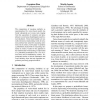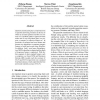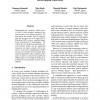84 search results - page 11 / 17 » A Topic Model for Word Sense Disambiguation |
EMNLP
2010
13 years 4 months ago
2010
The computation of meaning similarity as operationalized by vector-based models has found widespread use in many tasks ranging from the acquisition of synonyms and paraphrases to ...
CORR
1998
Springer
13 years 6 months ago
1998
Springer
Abstract. In many applications of natural language processing (NLP) it is necessary to determine the likelihood of a given word combination. For example, a speech recognizer may ne...
EMNLP
2008
13 years 8 months ago
2008
Question classification plays an important role in question answering. Features are the key to obtain an accurate question classifier. In contrast to Li and Roth (2002)'s app...
EMNLP
2008
13 years 8 months ago
2008
Bootstrapping has a tendency, called semantic drift, to select instances unrelated to the seed instances as the iteration proceeds. We demonstrate the semantic drift of bootstrapp...
COLING
2010
13 years 1 months ago
2010
Word Sense Disambiguation (WSD) often relies on a context model or vector constructed from the words that co-occur with the target word within the same text windows. In most cases...



